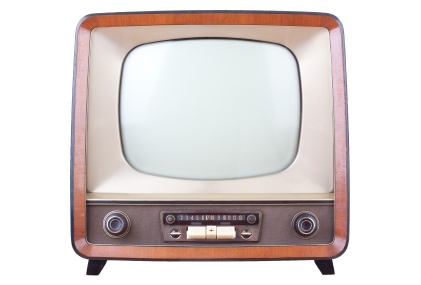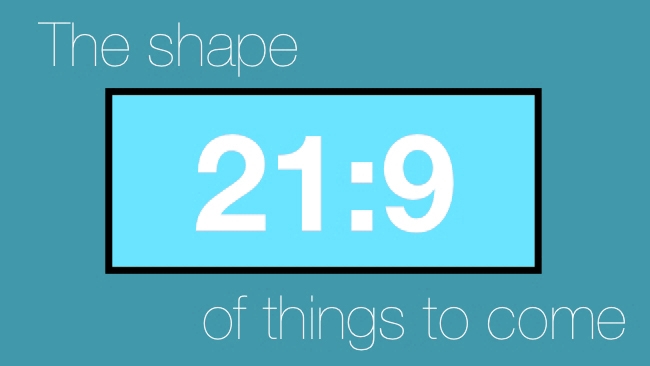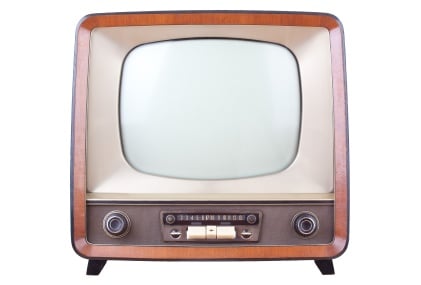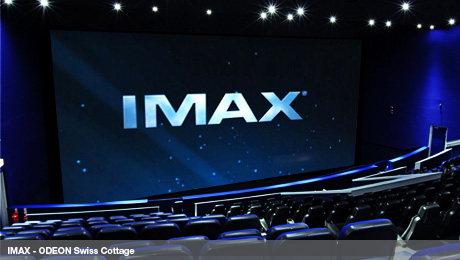
 The shape of things to come?
The shape of things to come?
RedShark Replay: Here's another chance to read our argument that wider screens would be better than 8K. Screens are getting wider: wider than widescreen. And this is a good thing
The next logical thing after 4K is 8K, or so we're told. But I think there's a better alternative, that will give a nicer visual experience, and which doesn't need the almost impossibly high bandwidth demanded by 8K. The idea is for wider than widescreen TV. Sounds impractical? Not at all. If it's implemented properly, everyone should be happy.
Here's how it could happen, starting with some background, and the story of how it even happened before.
Why not round?
If you didn’t know any better, you might be tempted to say that the best shape for a screen is completely round. For a start, your eyes are round: just look at your pupils. Camera lenses are round too, as are the images they produce. Very little in nature is square or rectangular, but plenty of things are naturally circular, or very nearly so.
But, quite obviously, based on the direction that video and film have taken so far in their short histories, this is not the correct answer.
You could be forgiven for thinking otherwise, though, in the early days of television. The first sets had screens that were very nearly circular. At the very least, they had extremely rounded edges. But this was probably more due to factors involved in Cathode Ray Tube manufacturing than anything else. Much later in the story of the CRT, we would see “Flatter, Squarer Tubes”, as if the technology was at last reaching the shape it was always intended to be. Now that we have moved beyond CRTs, screens are perfectly rectangular because it wouldn’t make any sense - and it would be difficult - to make them any other shape (triangular screens, anyone?).

Regardless of the shape of our eyes, our natural field of vision is very far from circular. Most of us have two working eyes, in a line horizontally with each other, and we have a very wide field of view. You can test this by holding a finger on each hand in front of your eyes and moving your arms round to the side. It’s quite surprising how far round - almost behind your head - you can still see.
So there is something rather natural about seeing an image on a screen that’s wider than it is tall, but at the same time, there is probably no natural or absolute law that says what the ratio between the horizontal and the vertical hight if the image should be.
Aspect ratio
When we’re talking about screens, there’s more to it than the so-called aspect ratio. There are other factors like the distance we’re sitting from the screen. At one extreme, you have a typical living-room situation where there’s a small screen and everyone’s sitting quite a long way back from it. In these circumstances, the amount of your total field of view taken up by the screen is very small. The opposite scenario is where you’re sitting so close to a very large screen that you can’t see all of it without moving your head. In this case, the shape of the screen hardly matters at all.

In between these you might have a big screen that you’re a medium distance from, which doesn’t fully fit your field of vision, but which covers the majority of it if you’re looking forward. This is what it’s like in a conventional modern cinema.
Whatever anyone might have thought about the original TV aspect ratio which was 4:3, the consensus was that it was too narrow. When you look at 4:3 productions now on a widescreen TV, they look absurdly narrow - almost square in fact, in comparison with the vast expanse of 16:9 that we’re now used to. Feature films, of course, are wider still, and that’s why we still have black bands at the top and bottom when this type of material is being shown. “Letterboxing” is a pretty good compromise, but it does waste a lot of the screen, leaving you with fewer pixels (ie a lower resolution) and a significantly smaller image, even on a big screen.

There is definitely a case for having even wider screens, and in the last week or so we’ve started to see 21:9 displays being announced, showing, at the very least, that it can be done.
It’s not as simple as making wider screens though, because there is no broadcast standard for 21:9 (which is mathematically very close to the modern cinema “standard” (one of many) of 2.35:1). And if you want to keep the resolution the same, 21.9 needs more “K” than 4K.
I’m based in Europe, where instead of moving directly from Standard Definition at 4:3 to High Definition at 16:9, we went through an “intermediate” phase of Standard Definition in 16:9 Widescreen. I’m very glad we did this because it was a distinct improvement, but you cannot believe the amount of confusion it caused non-technical users.
This is how it worked. At the time it was introduced, in the late nineties, we in the UK were in the process of moving from “traditional” analogue TV to digital terrestrial and satellite distribution. There was little point in upgrading the analogue TV broadcast system to widescreen (there were analogue widescreen TVs), but somehow it had to be made compatible with widescreen transmissions. The way this worked was a good example, if I may say so, of British ingenuity and compromise. (In fact, mostly compromise).
It would have been ludicrously expensive to adapt all studio and transmitting equipment to deal with widescreen, and the method chosen minimised the expense. All that happened was that widescreen TV was transmitted anamorphically. Images were framed for 16:9, and squeezed to fit a 4:3 aspect ratio. To view the images, widescreen sets unsqueezed the pictures to give a full 16:9 image. The beauty of this was that there was no need for special equipment. The same switchers and tape decks were able to deal with the widescreen images because as far as they were concerned they were just dealing with 4:3. The widescreen pictures themselves were created at the point of display, by the screens themselves. The only thing that needed to be changed were effects and titling programs, to make sure that circles didn't look like ovals, and that text didn't look too stretched.
Stretched
Of course a stretched or squeezed picture doesn't look too good on a TV that's not the image's intended shape. People often got the settings wrong but here's how it worked, at least in the UK.
For a long time, there was no such thing as a "digital" TV in the UK - where the "digital" part of it was the decoder box (The TVs themselves were as analogue as ever). One of the things the decoder box would do was see if the incoming signal was an anamorphic one. All of the boxes had settings where you could set the shape of your to 4:3 or 16:9. If you were lucky enough to have a 16:9 TV, the box would leave the signal alone, leaving it to the TV to stretch the image by simple virtue of the shape of its screen. If you had a digital box but only a 4:3 TV, the digital box would repackage a widescreen image so that it had black bars at the top and bottom, leaving an active image in the middle of the screen that was 16:9 in shape, but with a much reduced resolution because of all those wasted lines at the top and the bottom. And remember that this was only SD - so widescreen pictures displayed like this on a 4:3 screen had an effective resolution that was even less than SD!
Likewise, if you had a widescreen television but wanted to display a 4:3 picture, the decoder box would put black bars to the right and left of the picture, again wasting effective resolution.
In practise, if you had the settings right, these compromises worked well and for people that "got" widescreen - ie those that understood what it was for and what the potential benefits were - it was OK until the next generation of natively 16:9 sets came along and until broadcasting was fully 16:9 and fully HD.
If you didn't get it, and subjectively I think this might have been most of the UK population, then you probably had to get used to seeing short and fat people on your TV because you were trying to stretch a 4:3 originated image onto your 16:9 screen. There were other combinations that were even worse, and it is quite amazing, and somewhat disappointing, that people were prepared to sit through such an abomination.
Sony made a very nice 17" widescreen TV which made the point extremely well that even on a small screen it makes sense to have a wider image. The 24 hour BBC news channel has always been broadcast in Widescreen, and it looked fresh and new even on this little set.
Widescreen, though, isn't ideal for everything. My 16:10 computer monitor is better than 16:9 ones: those extra pixels at the top and bottom really matter. But for films and TV programs, it's much better watching in 16:9.
21:9 wouldn't be difficult
All of the above is there to show that if we were to move to a 21:9 standard for displays, it would not be difficult - or even expensive - to change our infrastructure to accommodate it.
For a start, most films are made in a ratio that is closer to 21:9 than 16:9, which was only ever intended to be a realistic compromise between film aspect ratios and the old 4:3 TV ratio. It could have been made even wider, but that would have left 4:3 images stranded in the middle of vast black bars. With the majority of material now being 16:9 at least, this is no longer an issue.
While most content is still being produced in 16:9, would the average viewer be prepared to have black bars either side of the picture (again!)? I think they would, not least because we've been mixing aspect ratios for a long time now and there are worse things than dark areas on the screen.
You could even take advantage of this situation (although this would depend on the context and mood of the viewer) and put extra information in the spare space on the screen.
As we've already seen, it's easy and cheap to deal with anamorphic material, at least if you're a broadcaster or a viewer. If you're a content producer, and if your content is not being captured natively in 21:9 (ie with square pixels for the whole, ultra-wide, picture) then it raises the spectre of rectangular pixels again. This can be confusing; it's easy to make mistakes and have circles looking like ovals. But it's worth it, I would say and we managed before so we could manage again.
In summary
So, here, in summary, is what I think the next step in TV should be.
It shouldn’t be 8K
Although this is a technological marvel, and there’s nothing intrinsically wrong with it, the fact that each 33 Megapixel frame is bigger than the vast majority of even high-end DSLRs can capture (the Canon 1DX has only 18 Megapixels and is reckoned to be the best DSLR you can buy) suggests that 8K for video is overkill. While it might be good for wall-sized screens, for most other uses, it’s overkill.
It should be 21:9
The only real hurdle here is getting the TV screens out there. Most feature films are shot in something approaching this aspect ratio anyway, and we’re used to seeing them letterboxed on 16:9 screens.
Anamorphic is OK
There are no sensors out there in 21:9 format. Absolutely the best way to make use of all the pixels on a relatively square sensor is to squeeze the image anamorphically at the point of capture, because this uses all the pixels on a 16:8 sensor, and then unsqueeze it later, either in post, if the actual transmission is to be in a 21:9 pixel format, or on the TV screen if it’s transmitted as 21:9 sqeezed to 16:9.
It uses less bandwidth than 8K
21:9 would entail using more pixels horizontally, but not vertically. Only about 75% more pixels (and hence bandwidth) would be needed, as opposed to four times increase over 4K needed for 8K. And if anamorphic transmission is used, there’s NO increase in bandwidth!
It would be a new way to watch sport
Sony and Panasonic already have technology that “stitches” the images from several, overlapping, camera fields of view. The idea is to give such a wide and detailed view of, say, a football (soccer) pitch that it’s not necessary to move the cameras at all. Currently, this is displayed using two 16:9 4K screens side by side. A single 21:9 screen is not as wide as this, but by zooming out slightly, the effect would be nearly as good and would fit onto one screen.
Ultrawide 21:9 screens aren’t going to be for everybody. They will be pretty big, even more expensive, and - to many people’s disappointment, I’m sure, you probably won’t be able to mount them on the wall, because they’ll probably be curved.
Why curved?
This isn’t just some whim of fashion. When screens get really wide, you have to turn your head or move your eyes significantly to see the corners. A better solution is to gently curve the screen around you, to keep the focusing distance the same, wherever you look. But this will make them more expensive, and also means you can’t mount them on a flat wall. It’s not the end of the world but it may be the end of the dream for wall-mountable TVs.
So that’s it. I haven’t heard this talked about elsewhere, but I do hope this really happens. Just because we can do 8K doesn’t mean that we shouldn’t, but it also doesn’t mean that we should quadruple resolution again without thinking about other important aspects of the picture. Wouldn’t it be better to focus for a while on framerate and colour depth? And how about a change for the better that no-one could say “I can’t see the difference” about? If you can’t tell the difference between a 16:9 screen and a 21:9 screen, then you should probably stick with the radio.
Tags: Technology



Comments